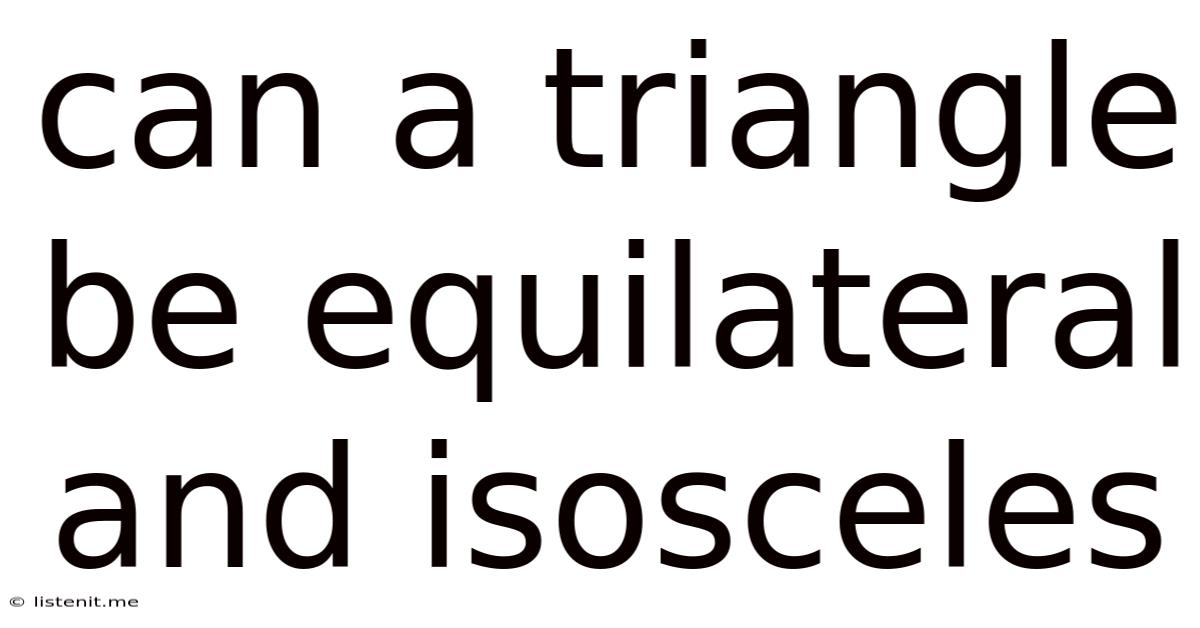Can A Triangle Be Equilateral And Isosceles
listenit
May 12, 2025 · 5 min read

Table of Contents
Can a Triangle Be Both Equilateral and Isosceles? Exploring the Relationship Between Triangle Types
The question of whether a triangle can be both equilateral and isosceles might seem trivial at first glance. The answer, however, offers a valuable opportunity to delve deeper into the fundamental definitions and properties of triangles, laying a strong foundation for understanding more complex geometric concepts. This article will explore this question in detail, clarifying the relationship between equilateral and isosceles triangles and examining the implications for their properties and applications.
Understanding the Definitions: Equilateral vs. Isosceles Triangles
Before we can definitively answer the central question, we must clearly define the terms "equilateral" and "isosceles" in the context of triangles.
Equilateral Triangles: The Perfect Symmetry
An equilateral triangle is defined as a triangle with all three sides of equal length. This inherent symmetry leads to several other important properties:
- All three angles are equal: Each angle in an equilateral triangle measures 60 degrees. This is a direct consequence of the equal side lengths.
- High degree of symmetry: Equilateral triangles possess rotational symmetry of order 3 (they can be rotated 120 degrees and still look the same) and three lines of reflectional symmetry.
Isosceles Triangles: At Least Two Equal Sides
An isosceles triangle is a triangle with at least two sides of equal length. These equal sides are called the legs, and the angle between them is called the vertex angle. The third side, which is potentially different in length, is called the base.
Note the crucial distinction: while an equilateral triangle has all three sides equal, an isosceles triangle only requires two equal sides. The third side can be equal to the other two, or it can be of a different length.
The Interplay: Can a Triangle Be Both?
Now, let's address the core question: Can a triangle be both equilateral and isosceles?
The answer is a resounding yes. An equilateral triangle perfectly fulfills the definition of an isosceles triangle. Since an equilateral triangle has all three sides equal, it inherently satisfies the condition of having at least two sides equal, which is the defining characteristic of an isosceles triangle.
Therefore, every equilateral triangle is also an isosceles triangle. However, the converse is not true. Not every isosceles triangle is an equilateral triangle. An isosceles triangle can have two equal sides and a third side of a different length.
Visualizing the Relationship: Venn Diagram Representation
A Venn diagram can effectively illustrate the relationship between equilateral and isosceles triangles:
Equilateral Triangles
/ \
/ \
/ \
/ \
/ \
/_______________\
Isosceles Triangles
The circle representing equilateral triangles is entirely contained within the circle representing isosceles triangles. This visually demonstrates that all equilateral triangles are a subset of isosceles triangles.
Implications and Applications: Exploring the Properties
Understanding the relationship between equilateral and isosceles triangles has implications in various areas:
Geometry: Angle and Side Relationships
The equal sides and angles of equilateral and isosceles triangles simplify many geometric calculations. For instance:
- Equilateral triangles: Knowing one side automatically gives you all three sides, and all angles are 60 degrees.
- Isosceles triangles: The angles opposite the equal sides are also equal. This property allows us to solve for unknown angles based on known angles or side lengths.
Trigonometry: Solving Triangles
Both equilateral and isosceles triangles simplify trigonometric calculations. The symmetries provide shortcuts and allow for easier application of trigonometric ratios (sine, cosine, tangent).
Construction and Design: Applications in Architecture and Engineering
Equilateral and isosceles triangles find numerous applications in architecture and engineering due to their inherent stability and symmetry. For example:
- Equilateral triangles: Often used in the construction of stable structures and trusses because of their uniform stress distribution.
- Isosceles triangles: Appear frequently in architectural designs, creating aesthetically pleasing shapes while offering structural advantages.
Computer Graphics and Game Development: Utilizing Geometric Properties
In computer graphics and game development, understanding these triangle types is fundamental:
- Equilateral triangles: Used in creating seamless textures and tiling patterns due to their perfect symmetry.
- Isosceles triangles: Used to build various shapes and models, enabling more versatile designs.
Advanced Concepts: Exploring Beyond the Basics
While the core concept of an equilateral triangle being a special case of an isosceles triangle is straightforward, we can explore some more advanced concepts:
Properties of the Centroid, Incenter, Circumcenter, and Orthocenter
In equilateral triangles, the centroid, incenter, circumcenter, and orthocenter all coincide at a single point. This unique property further highlights the high degree of symmetry in equilateral triangles. In isosceles triangles, these points do not generally coincide.
Transformations: Reflections and Rotations
The symmetry of both equilateral and isosceles triangles makes them ideal subjects for studying geometric transformations. Reflections and rotations are often used to explore their properties and relationships.
Area Calculations: Formulas and Comparisons
The area of an equilateral triangle can be calculated using a simple formula involving the side length. Isosceles triangles require different formulas depending on the known information (side lengths and angles).
Conclusion: A Foundation for Geometric Understanding
The seemingly simple question of whether a triangle can be both equilateral and isosceles leads us to a deeper appreciation of the fundamental definitions and properties of triangles. Understanding the relationship between these two triangle types provides a solid base for tackling more complex geometric problems and applications across various disciplines, from pure mathematics to computer science and engineering. The inherent symmetry and properties of these triangles make them indispensable tools in numerous fields. By mastering their characteristics, we unlock a more profound understanding of the world around us, shaped by the elegant principles of geometry.
Latest Posts
Related Post
Thank you for visiting our website which covers about Can A Triangle Be Equilateral And Isosceles . We hope the information provided has been useful to you. Feel free to contact us if you have any questions or need further assistance. See you next time and don't miss to bookmark.